13种贸易术语图解
2020年新编13种国际贸易术语解释课件名师精品资料
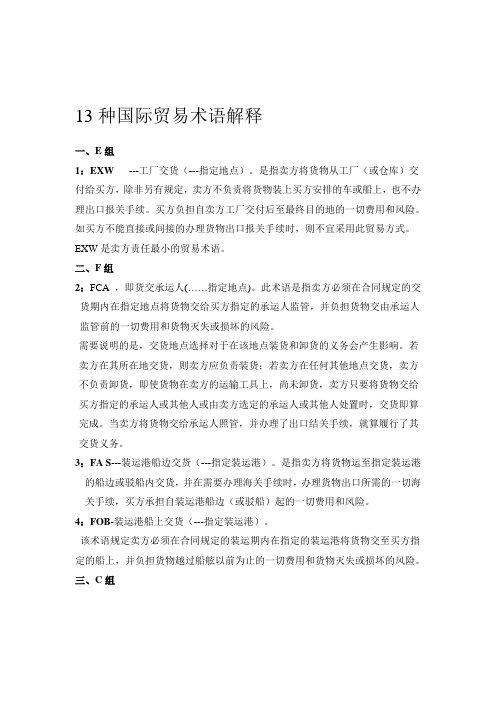
13种国际贸易术语解释一、E组1:EXW---工厂交货(---指定地点)。
是指卖方将货物从工厂(或仓库)交付给买方,除非另有规定,卖方不负责将货物装上买方安排的车或船上,也不办理出口报关手续。
买方负担自卖方工厂交付后至最终目的地的一切费用和风险。
如买方不能直接或间接的办理货物出口报关手续时,则不宜采用此贸易方式。
EXW是卖方责任最小的贸易术语。
二、F组2:FCA ,即货交承运人(……指定地点)。
此术语是指卖方必须在合同规定的交货期内在指定地点将货物交给买方指定的承运人监管,并负担货物交由承运人监管前的一切费用和货物灭失或损坏的风险。
需要说明的是,交货地点选择对于在该地点装货和卸货的义务会产生影响。
若卖方在其所在地交货,则卖方应负责装货;若卖方在任何其他地点交货,卖方不负责卸货,即使货物在卖方的运输工具上,尚未卸货,卖方只要将货物交给买方指定的承运人或其他人或由卖方选定的承运人或其他人处置时,交货即算完成。
当卖方将货物交给承运人照管,并办理了出口结关手续,就算履行了其交货义务。
3:FA S---装运港船边交货(---指定装运港)。
是指卖方将货物运至指定装运港的船边或驳船内交货,并在需要办理海关手续时,办理货物出口所需的一切海关手续,买方承担自装运港船边(或驳船)起的一切费用和风险。
4:FOB-装运港船上交货(---指定装运港)。
该术语规定卖方必须在合同规定的装运期内在指定的装运港将货物交至买方指定的船上,并负担货物越过船舷以前为止的一切费用和货物灭失或损坏的风险。
三、C组5:CFR ( -成本加运费(---指定目的港)。
是指卖方必须自阿合同规定的装运期内,在装运港将货物交至运往指定目的港的船上,负担货物越过船舷以前为止的一切费用和货物灭失或损坏的风险,并负责租船订舱,支付至目的港的正常运费。
6:CIF---成本加保险费、运费(---指定目的港)。
是指卖方必须在合同规定的装运期内在装运港将货物交至运往指定目的港的船上,负担货物越过船舷以前为止的一切费用和货物灭失或损坏的风险并办理货运保险,支付保险费,以及负责租船订舱,支付从装运港到目的港的正常运费。
13种贸易术语演示图
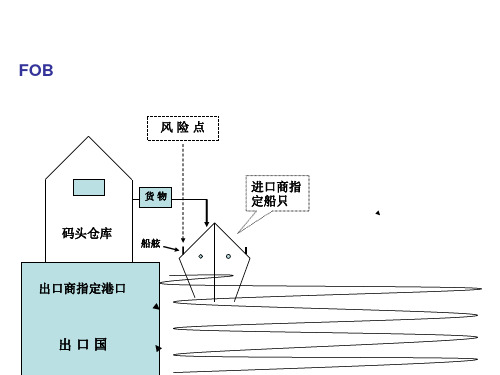
进口国
出口方
进口方
交货地点 风险.费用划分点 DAF术语下的交货地点.风险点.费用点示意图
EXW
出口商 工厂或仓库
货物
进 口 商
出口通关.运输.保险 等手续
EXW.FAS.DES.DEQ.DDU.DDP 交货/风险点示意图
DDU EXW 出口方 DEQ DES DDPFBiblioteka S进口方工厂/仓库
码头
码头
指定目的地
进口国
DDU出口商负担运费.保费.不含关税 DDP出口商负担运费.保费.含关税 DDU.DDP 出口商风险承担
FAS
进口商指定船只 码头 货物 驳船 出口商指定 港口 出口商风险.费用负担
A国
出口国
边 境 指 定 地 点
B国
进口国
出口商风险.费用负担
出 口 通 关
进 口 通 关
边境
出口国
工厂/仓库
出口国
进口国
机场
集装箱堆场 货运站
码头
DES
目的港
码头 仓库
海 关 码头 货物
出口国
出口商费用负担 ( 运费.保险费 ) DES 出口商风险承担 DES
进口国
DEQ
目的港 货物 海 关 码头
码头 仓库
出口国
出口商费用负担 ( 运费.保险费 )
进口国
DEQ
出口商风险承担
DEQ
DDU DDP
目的港
海 关
出口国
FOB
风险点
货物
进口商指 定船只
码头仓库
船舷
出口商指定港口
出口国
CFR
CIF
风险点
出 口 货 物
出口商指定船只
商务英语知识—贸易术语(有图解)
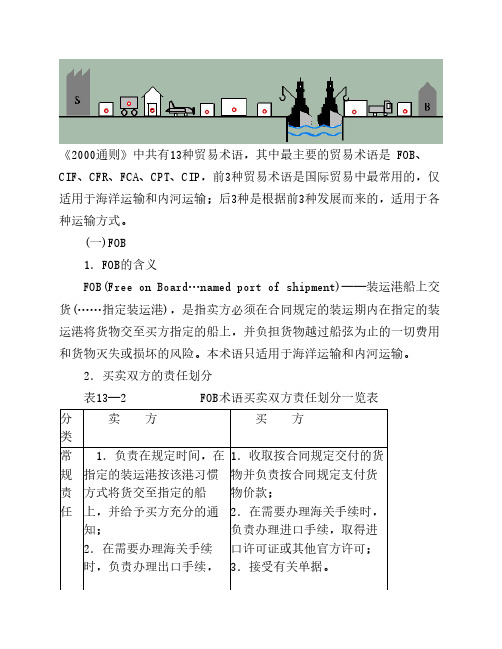
《2000通则》中共有13种贸易术语,其中最主要的贸易术语是 FOB、CIF、CFR、FCA、CPT、CIP,前3种贸易术语是国际贸易中最常用的,仅适用于海洋运输和内河运输;后3种是根据前3种发展而来的,适用于各种运输方式。
(一)FOB1.FOB的含义FOB(Free on Board…named port of shipment)——装运港船上交货(……指定装运港),是指卖方必须在合同规定的装运期内在指定的装运港将货物交至买方指定的船上,并负担货物越过船弦为止的一切费用和货物灭失或损坏的风险。
本术语只适用于海洋运输和内河运输。
2.买卖双方的责任划分表13—2 FOB术语买卖双方责任划分一览表 分类卖 方买 方 常规 责任 1.负责在规定时间,在指定的装运港按该港习惯方式将货交至指定的船上,并给予买方充分的通知;2.在需要办理海关手续时,负责办理出口手续,1.收取按合同规定交付的货物并负责按合同规定支付货物价款;2.在需要办理海关手续时,负责办理进口手续,取得进口许可证或其他官方许可;3.接受有关单据。
取得出口许可证或其他官方许可;3.负责提供交货凭证、运输单据或同等作用的电子讯息。
共同责任负担货物在装运港越过船舷前的一切费用和风险。
负担货物在装运港越过船舷后的一切费用和风险。
主要 责任 1.负责租船订舱,支付运费,并给予卖方关于船名、卖方的基本义务:办理出口清关手续,并负担货物越过装运港船舷以前的一切费用与风险。
在约定的装运期和装运港,把货物装到买方指定的船上,并及时向买方发出装船通知。
向买方提交约定的各项单证。
买方的基本义务:按时派船到约定的装运港接运货物,支付运费,并将船名和到港装货日期及时通知卖方。
承担货物越过装运港船舷时起的各种费用以及货物灭失或损坏的一切风险。
按合同规定付款赎单。
为便于记忆,FOB术语买卖双方的义务和责任归纳如表13-2。
3.FOB的变形以FOB条件买卖时,如果使用班轮运输,由于班轮一般管装管卸,一切费用都包括在运费之内,则装卸费用由支付运费的一方即买方负担。
商务英语知识—贸易术语(有图解)

《2000通则》中共有13种贸易术语,其中最主要的贸易术语是 FOB、CIF、CFR、FCA、CPT、CIP,前3种贸易术语是国际贸易中最常用的,仅适用于海洋运输和内河运输;后3种是根据前3种发展而来的,适用于各种运输方式。
(一)FOB1.FOB的含义FOB(Free on Board…named port of shipment)——装运港船上交货(……指定装运港),是指卖方必须在合同规定的装运期内在指定的装运港将货物交至买方指定的船上,并负担货物越过船弦为止的一切费用和货物灭失或损坏的风险。
本术语只适用于海洋运输和内河运输。
2.买卖双方的责任划分表13—2 FOB术语买卖双方责任划分一览表 分类卖 方买 方 常规 责任 1.负责在规定时间,在指定的装运港按该港习惯方式将货交至指定的船上,并给予买方充分的通知;2.在需要办理海关手续时,负责办理出口手续,1.收取按合同规定交付的货物并负责按合同规定支付货物价款;2.在需要办理海关手续时,负责办理进口手续,取得进口许可证或其他官方许可;3.接受有关单据。
取得出口许可证或其他官方许可;3.负责提供交货凭证、运输单据或同等作用的电子讯息。
共同责任负担货物在装运港越过船舷前的一切费用和风险。
负担货物在装运港越过船舷后的一切费用和风险。
主要 责任 1.负责租船订舱,支付运费,并给予卖方关于船名、卖方的基本义务:办理出口清关手续,并负担货物越过装运港船舷以前的一切费用与风险。
在约定的装运期和装运港,把货物装到买方指定的船上,并及时向买方发出装船通知。
向买方提交约定的各项单证。
买方的基本义务:按时派船到约定的装运港接运货物,支付运费,并将船名和到港装货日期及时通知卖方。
承担货物越过装运港船舷时起的各种费用以及货物灭失或损坏的一切风险。
按合同规定付款赎单。
为便于记忆,FOB术语买卖双方的义务和责任归纳如表13-2。
3.FOB的变形以FOB条件买卖时,如果使用班轮运输,由于班轮一般管装管卸,一切费用都包括在运费之内,则装卸费用由支付运费的一方即买方负担。
11种贸易术语图

序号 术语名称 交货地点 风险转移界限 出口报关责任、 进口报关责任、 出口报关责任、费 进口报关责任、费 使用的运输方式 用由谁承担 用由谁承担
1 2 3 4 5 6 7 8
EXW 工厂交货 FCA FAS FOB CFR CIF CPT CIP
商品产地、所在地
出口国内地、港口 货交承运人处置时起 出口国内地、港口 货交承运人处置时起 指定港口或目的地 货物交买方处置时起 的指定运输终端 可供卸载的货物交 由买方处置时起 在指定目的地将货 物交由买方处置时 起
9
DAT
卖方
买方
任何方式
10
DAP
指定目的地
卖方
买方
任何方式
11
DDP
进口国内
卖方
卖方方 卖方 卖方 卖方 卖方 卖方 卖方
买方 买方 买方 买方 买方 买方 买方 买方
任何方式 任何方式 水上运输 水上运输 水上运输 水上运输 任何方式 任何方式
出口国内地、港口 货交承运人处置时起 装运港口 装运港口 装运港口 装运港口 货交船边后 货物交到船上时 货物交到船上时 货物交到船上时
13种国际贸易术语
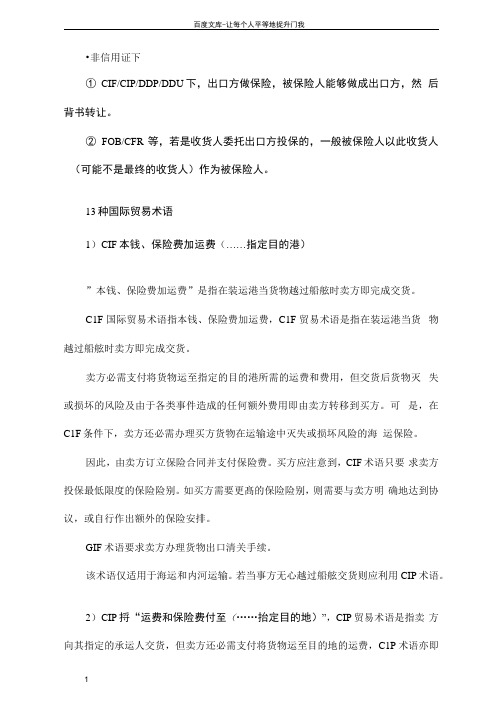
•非信用证下①CIF/CIP/DDP/DDU下,出口方做保险,被保险人能够做成出口方,然后背书转让。
②FOB/CFR等,若是收货人委托出口方投保的,一般被保险人以此收货人(可能不是最终的收货人)作为被保险人。
13种国际贸易术语1)C IF本钱、保险费加运费(……指定目的港)”本钱、保险费加运费”是指在装运港当货物越过船舷时卖方即完成交货。
C1F国际贸易术语指本钱、保险费加运费,C1F贸易术语是指在装运港当货物越过船舷时卖方即完成交货。
卖方必需支付将货物运至指定的目的港所需的运费和费用,但交货后货物灭失或损坏的风险及由于各类事件造成的任何额外费用即由卖方转移到买方。
可是,在C1F条件下,卖方还必需办理买方货物在运输途中灭失或损坏风险的海运保险。
因此,由卖方订立保险合同并支付保险费。
买方应注意到,CIF术语只要求卖方投保最低限度的保险险别。
如买方需要更髙的保险险别,则需要与卖方明确地达到协议,或自行作出额外的保险安排。
GIF术语要求卖方办理货物出口清关手续。
该术语仅适用于海运和内河运输。
若当事方无心越过船舷交货则应利用CIP 术语。
2)C IP捋“运费和保险费付至(……抬定目的地)”,CIP贸易术语是指卖方向其指定的承运人交货,但卖方还必需支付将货物运至目的地的运费,C1P 术语亦即买方承担卖方交货以后的一切风险和额外费用。
可是,依照CIP术语, 卖方还必需办理买方货物在运输途中灭失或损坏风险的保险。
因此,由卖方订立保险合同并支付保险费。
买方应注意到,C1P术语只要求卖方投保最低限度的保险险别。
如买方需要更高的保险险别,则需要与卖方明确地达到协议,或自行作出额外的保险安排。
3)D DP贸易术语指完税后交货(……指定目的地),DDP术悟是指卖方在指定的目的地,办理完入口清关手续,将在交货运输工具上尚未卸下的货物交与买方,完成交货。
贸易术语DDP卖方必需承担将货物运至指定的目的地的一切风险和费用,包括在需要办理海关手续时在目的地应交纳的任何“税费”(包括办理海关手续的责任和风险,和交纳手续费、关税、税款和其他费用)。
13种常用国贸术语PPT精品文档17页

指定目
船
船
到达卸货港
的地交 货:边境 /机场/码
进口单证 手续
买方/进 口商
地点
上舷
头
买方风险
卖方费 用
买方费用
卖方责 任
买方责 任
CIP(Carriage and Insurance Paid to)
注:卖方 买方
卖方/出 口商
地点
出口单证 边境/机场/
手续
码头交货
卖方风 险
装运港
海洋
船舷 船上
地点
上舷
头
买方风险
卖方费 用
卖方责 任
买方费用
买方责 任
DDU(Delivered Duty Unpaid)
注:卖方 买方
卖方/出 口商
地点
出口单证 边境/机场/
手续
码头交货
卖方风 险
装运港
海洋
船舷 船上
买方
指定目
船
船
到达卸货港
的地交 货:边境 /机场/码
进口单证 手续
买方/进 口商
地点
上舷
头
买方风险
到达卸货港
的地交 货:边境 /机场/码
进口单证 手续
买方/进 口商
地点
上舷
头
买方风险
卖方费 用
买方费用
卖方责 任
买方责 任
DES(Delivered EX Ship)
注:卖方 买方
卖方/出 口商
地点
出口单证 边境/机场/
手续
码头交货
卖方风 险
装运港
海洋
船舷 船上
买方
指定目
船
船
到达卸货港
13种贸易术语图解
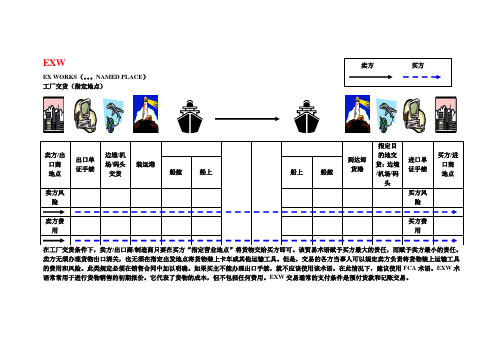
EXWEX WORKS(。
NAMED PLACE)工厂交货(指定地点)在工厂交货条件下,卖方/出口商/制造商只要在买方“指定营业地点”将货物交给买方即可。
该贸易术语赋予买方最大的责任,而赋予卖方最小的责任。
卖方无须办理货物出口清关,也无须在指定出发地点将货物装上卡车或其他运输工具。
但是,交易的各方当事人可以规定卖方负责将货物装上运输工具的费用和风险。
此类规定必须在销售合同中加以明确。
如果买主不能办理出口手续,就不应该使用该术语。
在此情况下,建议使用FCA术语。
EXW术语常常用于进行货物销售的初期报价。
它代表了货物的成本,但不包括任何费用。
EXW交易通常的支付条件是预付货款和记账交易。
FCAFREE CARRIER(。
NAMED PLACE)货交承运人(指定地点)在货交承运人条件下,卖方/出口商/制造商负责货物出口清关并随后在指定地点交付买方指定的承运人。
如果指定地点系卖方营业地点,则卖方负责将货物装上运输工具。
如果指定地点是另外一个地点,如承运人的装运码头,则卖方不负责将货物装上运输工具。
货交承运人条件可以用于任何运输方式,包括多式联运。
货交承运人和所有“F”组术语下的“指定地点”均在卖方国内。
“承运人”具有狭义和广义的含义。
承运人可以是一家航空公司、航运公司、卡车运输公司或者铁路。
承运人也可以是一个采用上述任何运输方式,包括多式联运进行运输的个人或企业。
所以,一个个人,例如货运代理商,在这一术语下可以担任“承运人”的角色。
该术语经常用于货物销售的初期报价。
该术语通常的付款条件是预付货款和记账交易。
FASFREE ALONGSIDE SHIP(。
NAMED PORT OF SHIPMENT)船边交货(指定装运港)在船边交货条件下,卖方/出口商/制造商负责货物出口清关并随后将货物置于“指定装运港”的船边。
但是,交易的各方当事人可以在其销售合同中规定买方办理货物出口清关。
船边交货条件仅可用于海洋或内河水运。
1 13种贸易术语 图解
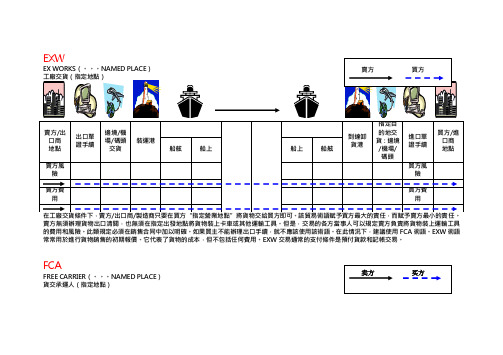
EXWEX WORKS(。
NAMED PLACE)賣方無須辦理貨物出口清關,也無須在指定出發地點將貨物裝上卡車或其他運輸工具。
但是,交易的各方當事人可以規定賣方負責將貨物裝上運輸工具的費用和風險。
此類規定必須在銷售合同中加以明確。
如果買主不能辦理出口手續,就不應該使用該術語。
在此情況下,建議使用FCA術語。
EXW術語常常用於進行貨物銷售的初期報價。
它代表了貨物的成本,但不包括任何費用。
EXW交易通常的支付條件是預付貨款和記帳交易。
FCAFREE CARRIER(。
NAMED PLACE)貨交承運人(指定地點)物裝上運輸工具。
如果指定地點是另外一個地點,如承運人的裝運碼頭,則賣方不負責將貨物裝上運輸工具。
貨交承運人條件可以用於任何運輸方式,包括多式聯運。
貨交承運人和所有“F”組術語下的“指定地點”均在賣方國內。
“承運人”具有狹義和廣義的含義。
承運人可以是一家航空公司、航運公司、卡車運輸公司或者鐵路。
承運人也可以是一個採用上述任何運輸方式,包括多式聯運進行運輸的個人或企業。
所以,一個個人,例如貨運代理商,在這一術語下可以擔任“承運人”的角色。
該術語經常用於貨物銷售的初期報價。
該術語通常的付款條件是預付貨款和記帳交易。
FASFREE AL ONGSIDE SHIP(。
NAMED PORT OF SHIPMENT)買方辦理貨物出口清關。
船邊交貨條件僅可用于海洋或內河水運。
船邊交貨和所有“F”組術語下的“指定地點”均在賣方國內。
船邊交貨術語經常用於散裝貨,如石油、糧食和礦石等商品的銷售。
該術語通常的付款條件是預付貨款和記帳交易。
FOB ArrayFREE ON BOARD(。
NAMED PORT OF SHIPMENT)船上交貨和所有“F”組術語下的“指定地點”均在賣方國內。
船上交貨術語經常用於如石油、糧食和礦石等大宗商品的銷售。
這些商品的銷售中,越過船舷非常重要。
然而,它也常用於其他貨物的集裝箱運輸。
船上交貨交易中主要的檔是“已裝船提單”。
贸易术语大全

贸易术语大全.贸易术语大全目录一. 贸易术语二.商品的品名、品质、数量与包装三.贸易方式四.国际货物运输保险五.进出口商品的价格六.国际货款的收付七.商品检验、索赔、不可抗力与仲裁八.国际货物买卖合同的商订九.进出口合同的履行十.国际货物运输贸易术语在国际货物买卖过程中,有关交易双方责任和义务的划分。
是一个十分重要的问题。
为了明确交易双方在货物交接过程中,有关风险,责任和费用的划分,交易双方在洽商交易和订立合同时。
通常都要商定采用何种贸易术语,并向合同中具体订明。
贸易术语是国际货物买卖合同中不可缺少的重要内容,因此,从事国际贸易的人员,必须了解和掌握国际贸易中现行的各种贸易中贸易术语及其他有关的国际贸易惯例,以便正确选择和使用各种贸易术语.一、贸易术语的产生及其性质与作用。
1. 贸易术语的产生贸易术语(Trade Terms)是国际贸易发展到一定历史阶段的产物。
它的产生是同国际贸易的特点和国际运输,保险及通讯事业工具,装卸货物,投保货运险,报关,纳税人等手续,并需支付运费,保险费,装卸费以及其它各项费用,同时货物在运输,装卸过程中,还可能遭遇到自然灾害,意外事故和各种外来风险,有关这些事项由谁办理,费用由谁支付,风险由谁承担,,买卖双方在磋商交易和订立合同时,必须明确予以规定,为了明确交易双方各自承担的责任,费用和风险,便采用专门的贸易术语来表示,随着国际贸易和交通运输与通讯事业的发展,国际上采用的贸易术语也日渐增多,除传统的贸易术语,近年来又出现了一些新的贸易术语。
2. 贸易术语的性质贸易术语是用来表示买卖双方各自承担义务的专门用语,每种贸易术语都有其特定的含义,采用某种专门的贸易术语,主要是为了确定交货条件,即说明买卖双方在交接货物方面彼此承担责任,费用和风险的划分。
例如,按装运港船上交货条件(FOB)成交同按目的港船上交货条件(DES)成交,由于交货条件不同,买卖双方各自承担的责任,费用和风险,就有很大区别,。
贸 易 术 语 图 示
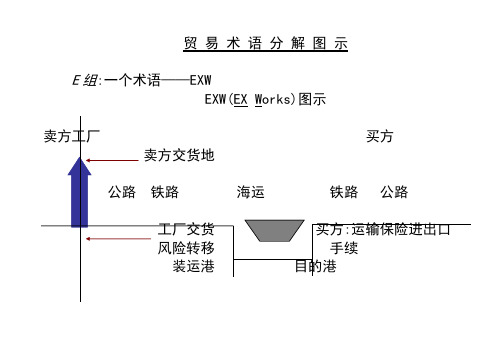
贸易术语分解图示
E组:一个术语——EXW
EXW(EX Works)图示
F组:三个术语——FCA、FAS、FOB
FCA(Free Carrier)图示
FAS(Free along-side Ship)图示
FOB(Free on Board)图示
卖方工厂买方
装运港船上交货
风险在船舷转移
海运铁路公路
C组:四个术语——CFR、CIF、CPT、CIP
CFR(Cost and Freight)图示
卖方工厂买方
装运港船上交货
风险在船舷转移
海运铁路公路
CIF(Cost, Insurance and Freight)图示卖方工厂买方
海运铁路公路
CPT(Carriage Paid to)图示
卖方:运输出口手续买方:保险进口手续
装运港目的港
CIP(Carriage, Insurance Paid to)图示
装运港目的港
D组:五个术语——DAF、DES、DEQ、DDU、DDP
DAF(Delivered at Frontier)图示
DES(Delivered EX Ship)图示
卖方工厂买方
DEQ(Delivered EX Quay)图示
卖方工厂买方
目的港码头交货
交货时风险转移
公路铁路海运铁路公路
DDU(Delivered Duty Unpaid)图示
卖方工厂买方
卖方:运输保险出口手续买方:进口手续
DDP(Delivered Duty Paid)图示
卖方工厂买方
贸易术语列表图示。
2024版贸易术语(共54张PPT)

贸易术语(共54张PPT)contents •贸易术语概述•常见贸易术语解析•贸易术语在合同中的应用•贸易术语与支付方式关系探讨•贸易术语在物流环节中的应用•跨境电商中贸易术语应用实践•总结与展望目录贸易术语概述01CATALOGUE定义与分类定义贸易术语是指在国际贸易中,用于描述交易条件、交货方式、支付手段等方面的标准化用语。
分类根据使用范围和性质,贸易术语可分为国际贸易术语、国内贸易术语以及行业特定术语等。
标准化贸易术语具有标准化的特点,使得不同国家和地区的贸易商能够准确理解和沟通。
专业化贸易术语涉及专业领域的知识和规则,要求使用者具备一定的专业素养。
•更新快:随着国际贸易的发展和变化,贸易术语也在不断更新和完善。
使用标准化的贸易术语可以提高交易双方的沟通效率,减少误解和歧义。
提高沟通效率明确交易条件促进国际贸易发展贸易术语明确了交易条件、交货方式、支付手段等关键要素,有助于降低交易风险。
统一的贸易术语有助于促进国际贸易的发展,提高市场透明度和竞争公平性。
030201国内外贸易术语比较国内贸易术语国内贸易术语主要适用于国内市场的交易活动,涉及国内法律法规、商业惯例和交易习惯等方面。
国内贸易术语相对简单,容易理解和应用。
国际贸易术语国际贸易术语适用于跨国或跨地区的交易活动,涉及国际法律法规、国际贸易惯例和不同国家的商业习惯等方面。
国际贸易术语较为复杂,需要使用者具备较高的专业素养和跨文化沟通能力。
比较分析国内外贸易术语在定义、分类、使用范围和性质等方面存在差异。
在国际贸易中,正确理解和应用相关术语对于保障交易双方的权益至关重要。
因此,对于从事国际贸易的企业和个人来说,掌握国内外贸易术语的差异和联系具有重要意义。
常见贸易术语解析02CATALOGUEFOB(装运港船上交货)定义01FOB是国际贸易中的一种术语,指的是当货物在指定的装运港越过船舷后,卖方即完成交货。
这意味着买方必须从该点起承担货物灭失或损坏的一切风险。
国际贸易术语图解
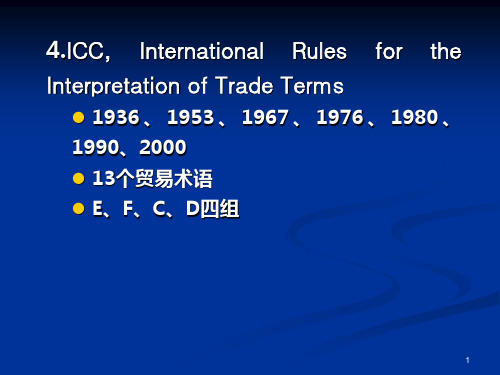
FOB CFR CIF
DDU DDP
DES
DE Q
36
运费划分地点示意图
CPT CIP DDU DDP
FCA EXW FOB CFR CIF DES DE Q
FAS
37
出口结关手续
由卖方办理的: FCA,FAS, FOB,CFR, CIF,CPT, CIP,DAF, DES,DEQ, DDU,DDP
international trade community.
6
(三)INCOTERMS’2000的内容 E组:EXW
F组:FCA、FAS、FOB C组:CFR、CIF、CPT、CIP D组:DAF、DES、DEQ、DDU、DDP A: the seller’s obligations B: the buyer’s obligations
10
交货地点 风险转移地点 费用划分地点
11
F组
FCA
Free
Carrier(…named place)
货交承运人(指定地点)
12
交货地点
风险转移地点 费用划分地点
13
FAS
Free Alongside shipment) Ship(…named port of
船边交货(指定装运港)
B3 Contract of carriage
A4 Delivery; B4 Taking delivery
A5 Transfer of risks
B5 Transfer of risks
8
A6 Division of costs B6 Division of costs A7 Notice to the buyer B7 Notice to the seller A8 Proof of delivery, transport document or equivalent electronic message B8 Proof of delivery, transport document or
13个贸易术语交货图
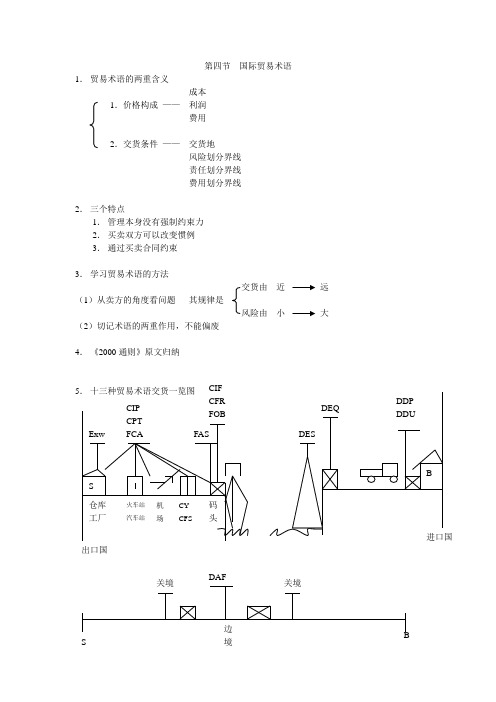
第四节国际贸易术语1.贸易术语的两重含义成本1.价格构成——利润费用2.交货条件——交货地风险划分界线责任划分界线费用划分界线2.三个特点1.管理本身没有强制约束力2.买卖双方可以改变惯例3.通过买卖合同约束3.学习贸易术语的方法交货由近远(1)从卖方的角度看问题其规律是风险由小大(2)切记术语的两重作用,不能偏废4.《2000通则》原文归纳6.贸易术语的运用1)掌握《2000通则》规定的双方各项义务P3522)合同中价格条例举例A.“X”pc 500.00USD FOB Shanghai“X”商品FOB 上海交货价每件50.00美元上海A公司向美国纽约进口商出口货物:B.“X”pc 52.50USD CIF New York“X”商品CIF 纽约价每件52.50 美元(但该条款的交货地在上海港装船,仅在“X”商品的价格构成中含有到目的港纽约的运费、保险费,A公司将货物在上海港装船、货物越过船骇以后的风险都由买方承担,C组的其他术语也有此特点—即风险与费用相分离,请学员切记)3)CIF单据买卖——象征性交货的含义——象征物权的凭证—提单,即卖方向买方交付了提单即为交货。
P3584)正确理解贸易术语变形的作用,一般它不改变贸易术语惯例对交货地点和风险划分的界线5)FOB、CFR、CIF术语订主的合同装运即为交货如:CIF合同规定:time of shipment (装运时间)7月15日另有规定time of delivery (交货时间)8月15日是不合适的,容易被误解为8月15日为实际交货期限,根据《2000通则》的解释7月15日卖方将货物装船时越过船舷,即为交货。
所以完整的理解CIF含义,它并不是到岸价,而离岸价。
13种贸易术语的比较归纳-贸易术语的归纳总结

13种贸易术语归纳对比贸易术语交货地点风险转移界限出口报关责任进口报关责任适用运输方式风险EX W卖方工厂、仓库买方处置后买方买方任意小FC A出口国、地货交承运人卖方任意FA S装运港船边船边海运F OB装运港船上船舷海运CF R装运港船上船舷海运CI F装运港船上船舷海运CP T出口国、地货交承运人任意CI P出口国、地货交承运人任意D AF边境指定地买方处置后任意D ES目的港船上买方收货后海上D EQ目的港码头买方在码头收货后海上D DU进口国内买方指定地收货后任意D DP进口国内买方指定地收货后卖方任意大FOB、CIF、CFR异同比较:共同点:1、三种价格术语都适用于海运和内河运输,其承运人一般只限于船公司。
2、三种价格术语交货点均为装运港船舷风险点均以在装运港越过船舷即从卖方转移至买方。
3、费用点:卖方均要承担货物在装运港越过船舷为止的一切费用。
4、提单:卖方均需向买方提交已装船清洁提单。
5、装船通知:装运前后卖方均应及时向买方发出装船通知。
6、风险点:卖方在装运港将货物装船后的风险即转移到买方。
7、目的港的进口清关,费用等均由买方负责办理;装运港的装船,陆运,出口报关,办理许可证等均由卖方办理。
8、卖方都有在装运港安排订舱、配船的义务。
不同点:1、价格术语后港口性质不一样,FOB后的港口指卖方所在国的港口,而CFR与CIF 后的港口指买方所在国的港口2、费用构成不一样,报价不一样。
FOB价格是考虑货物从原料购进、生产直到出口报关货物装到买方指定船舱同的一切费用和利润为止,而CFR是在FOB价格的基础上再加上海运费,CIF则是在FOB价格的基础上再加上海运费和保险费。
3、码头作业费的支付对象不同。
按照谁支付海运费谁支付THC费用的原则,FOB价格条款中THC费用应由买方承担,CFR与CIF中THC应由卖方承担,现行国内THC标准为20‘柜370元,大柜40’为560元,THC费用应在贸易合同中明确注明由谁支付。
13种贸易术语演示图
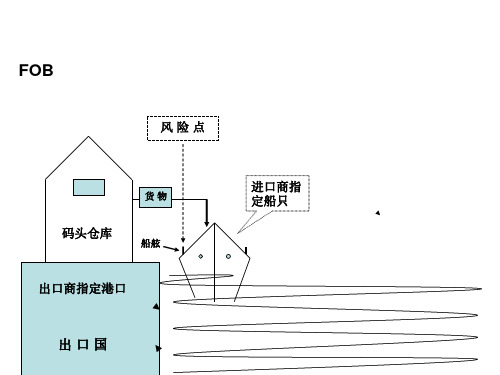
出口方 进口方
工厂/仓库 工厂 仓库
火车站 汽车站
机场
集装箱堆场 货运站
码头
DES
目的港
码头 仓库
码头 货物
海 关
出口国
运费.保险费 出口商费用负担 ( 运费 保险费 ) DES 出口商风险承担 DES
进口国
DEQ
目的港 货物 海 关
码头 仓库
码头
出口国
运费.保险费 出口商费用负担 ( 运费 保险费 )
交单
契约 即期付款交单
进口商 付款人
4 进 口 地 银
受票人
7 托
商 装
1.
票
即期付款 交单
行 示 收 付 款 人 付 款 托 收 通 单 知 书 提 附 赎 并 款 据 付 单 人 到 票 受
付款人付款
3.即期付款交单
付款
4.
委托人
3
出口 托
6 付托
进口
5
承兑交单
1 1
出口商 委托人 出票人
交 出 出 口 口 地 收 银 行 收 到 货 款 后 转 交 出 票 人 据 2 托进口 单 运 货 及 款 汇 票
5
12
DRAFT S AT SIGHT DRAWN ON ISSUING BANK 人
DRAFT S AT SIGHT DRAWN ON APPLICANT 6 3
2
11 8 9
1
合 同 L/C
1
受益人
7 4 依 规 定 贴 期 现 扣 除 手 续 费 求 、 垫 付 货 款 6 3 付 2 议 请 据 证 、 单 , 信 用 票 改 汇 修 查 用 1 2 款 书 付款 请 申 证 远 审 信 发 递 立 签 传 开 5
13贸易术语图表
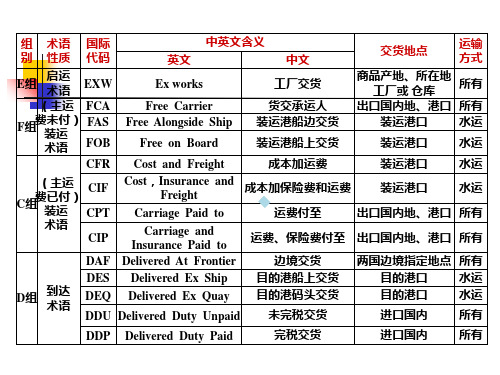
指卖方负担货物装船和理舱的费
舱的费用。
用。
上述FOB后加列各种条件,只是为了明确装货费由谁负担, 并不影响风险转移的界限。
(5)CFR 成本加运费 Cost and FReight (named port of destination)
• 交货地点 • 卖方的运输责任 • 装船通知 • CFR = FOB + F
• 装船费用的划分 — FOB liner terms — FOB under tackle
— FOBST
FOB 班轮条件
FOB 包括平舱(FOB Trimmed)
FOB变形的常见种类 (FOB Liner Terms)
指卖方负担货物装船和平舱的
指装货费按班轮办法处理,即卖
费用。
方不负担。
FOB包括理舱和平舱(FOB
_ 卖方只负责装货 • “承运人” 的界定
(3)FAS 装运港船边交货 Free Alongside Ship (named port of shipment)
• 运输方式 • 船货衔接
(4)FOB 装运港船上交货
Free On Board (named port of shipment)
• 船舷为界 • 船货衔接 • 装运通知
组 术语 国际 别 性质 代码
中英文含义 英文
中文
交货地点
运输 方式
E组
启运 术语
EXW
Ex works
工厂交货
商品产地、所在地 工厂或 仓库
所有
(主运 FCA F组费装未运付) FAS
术语 FOB
Free Carrier Free Alongside Ship
Free on Board
贸易术语图解
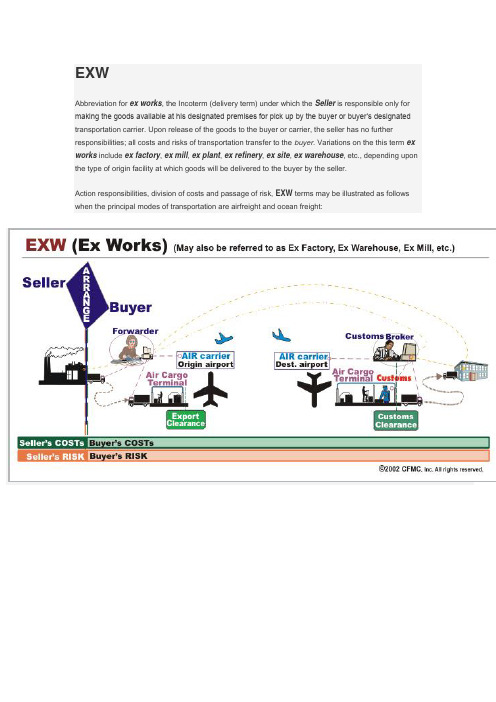
EXWAbbreviation for ex works, the Incoterm (delivery term) under which the Seller is responsible only for making the goods available at his designated premises for pick up by the buyer or buyer’s designated transportation carrier. Upon release of the goods to the buyer or carrier, the seller has no further responsibilities; all costs and risks of transportation transfer to the buyer. Variations on the this term ex works include ex factory, ex mill, ex plant, ex refinery, ex site, ex warehouse, etc., depending upon the type of origin facility at which goods will be delivered to the buyer by the seller.Action responsibilities, division of costs and passage of risk, EXW terms may be illustrated as follows when the principal modes of transportation are airfreight and ocean freight:The official Incoterms publications (Incoterms 2010) may be ordered from the International Chamber of Commerce.FCA(Incoterms) Abbreviation for free carrier (named place). The Incoterm (delivery term) under which the seller is responsible for handing over the goods, cleared for export, to a transportation carrier named by the buyer at a named location, typically at either the seller’s facility or else the terminal of thebuyer-nominated carrier or freight forwarder, typically within the country of export. If the FCA point is the seller’s facility, and loading the conveyance is essential to “handing over the goods,” the seller is responsible for the risk and expense of loading (if loading is not otherwise included in the carrier’s basic transportation charge). FCA, shipper’s facility, is the appropriate delivery term for situations in which the shipper will load an intermodal container, truck trailer, rail car, barge or other conveyance.The seller is not responsible for the cost of unloading the conveyance at the named destination point, nor for transfer of the goods to the on-carrier. For example, if the FCA point is an ocean carrier and/or inland waterway terminal (other than the seller’s own facility), the buyer is responsible for unloading the incoming FCA conveyance, inclusive of forklift charge or other expenses, and for loading the outgoing vessel (e.g., the terminal charges, or wharfage and handling charge, etc.). See also FOB (vessel), under which the seller is additionally responsible for the cost of loading the vessel. Under FCA terms, the seller has no obligation to insure the shipment.Action responsibilities, division of costs and passage of risk under FCA terms may be illustrated as follows when the principal modes of transportation are airfreight and ocean freight:Responsibility for govern security requirements: Incoterms 2010 changed rules A2 & B2, now captioned “Licenses, authorizations, security clearances and other formalities,” to include government imposed security requirements, whatever they may be, as part of export formalities and import formalities. The trading party responsible for export formalities is thus responsible for security requirements in the export country whereas the party responsible for import formalities is responsible for security responsibilities in the import country. For security requirements in a transit country, if any, if the seller has accomplished delivery under the applicable term, the buyer is responsible for this; otherwise security requirements are the seller’s responsibility.FAS(Incoterms) Abbreviation for free alongside. The Incoterm (delivery term) under which the seller is responsible for arranging transportation of the goods to a named ocean or inland waterway port and placing them “alongside” the vessel which the buyer has arranged to transport the goods. The seller is also responsible for export clearance (under pre-2000 versions of Incoterms, this was the buyer’s responsibility). For this reason, FAS terms require special coordination by the shipper or freight forwarder with the inland carrier and water carrier. Under FAS terms, the seller has no obligation to insure the shipment. See Also definitions for ship’s rail, ship’s tackle and shipside delivery.Note: This term is used for shipment via ocean and inland water transportation only and is different from FOB in that the seller is not responsible for placing the goods on the vessel.Action responsibilities, division of costs and passage of risk, FAS terms may be illustrated as follows:Responsibility for government security requirements: Incoterms 2010 changed rules A2 & B2, now captioned “Licenses, authorizations, security clearances and other formalities,” to include government imposed security requirements, whatever they may be, as part of export formalities and import formalities. Under FAS terms, the seller is responsible for export formalities and thus also security requirements in the export country whereas the buyer is responsible for import formalities and thus for security responsibilities in the import country. For security requirements in a transit country, if any, since the seller has already accomplished delivery, the buyer is responsible for this.FOB(Incoterms) Abbreviation for free on board. The Incoterm (trade term) under which the seller is responsible for arranging transportation of goods to a vessel named by the buyer at a namedport, and for all costs of placing t he goods on board the vessel if this not included in the ocean carrier’s basic transportation rate (which it rarely is—see terminal charge, handling charge). The seller’s responsibility is satisfied when the cargo is “on-board” the vessel. The seller is not responsible for costs of actually stowing the goods on board, but is responsible for that portion of the terminal charges which cover services other than stowage and vessel wharfage charges. The seller is not responsible for the cost of ocean carriage, marine cargo insurance, nor for arranging the contract of carriage unless the buyer requests his assistance with this. This Incoterm may never be used alone; rather it must be clarified by stating a specific location, an, because of possible uncertainty as to mode (see box below) the type of conveyance (e.g., “FOB vessel, Baltimore”).ImportantUnder Incoterms 1990 and 2000, “FOB” may be used only for shipments via vessel (prior to these editions, “fob” could be used with other transportation modes). However, “fob” remains applicable to all modes under the American Foreign Trade Definitions (terms of sale). Furthermore, as traditionally used, “fob” can become ambiguous as to whether it means on board the carrier at point of origin vs. destination. For example, “FOB truck, Baltimore” would typically describe a shipment originating in Baltimore by truck. But it might also be used to describe goods shipped prepaid by a supplier consigned to an exporter, at a port city, hold and notify the exporter or his freight forwarder. To eliminate these problems, and to create the precision needed for EDI transactions, Incoterms 1990dropped all use of “FOB” except with respect to the trade term under which the seller is responsible for placing the cargo on-board a vessel at a named origin port. Otherwise, “FOB” was replaced with “FCA.” Notwithstanding this change in the Incoterms, “fob” continues to be widely used domestically and by U.S. exporters for modes of transportation other than vessel, which can result in ambiguity and confusion. When in doubt as to the intention of theseller/shipper as to their use of “fob” for a particular transaction, always clarify this before further dispatching or forwarding cargo.See also definitions for FOB stowed (FOBS), FOB stowed and trimmed (FOBST), FOBFO and FOBLO, which are used with charter vessels and/or bulk vessels, and FOB liner.Action responsibilities, division of costs and passage of risk, the FOB trade term may be illustrated as follows:CPT(Incoterms) Abbreviation for carriage paid to; the Incoterm (delivery term) under which the seller is responsible for arranging transportation and paying the freight for goods to a named point, typically in the destination country. Note, however, that the seller has fulfilled his obligation when he has tendered the goods to the transportation carrier who, under the contract of carriage, will accomplish this transportation to the named point. At this point, typically in the origin country, the buyer assumes the risk of loss of the goods and/or unforeseeable costs. This Incoterm may be used with any transportation mode, including through multimodal movements. Under CPT terms, the seller has no obligation to insure the shipment.In terms of action responsibilities, division of costs and passage of risk, CPT terms may be illustrated as follows where the principal modes of transportation are airfreight and ocean freight:Responsibility for government security requirements: Incoterms 2010 changed rules A2 & B2, now captioned “Licenses, authorizations, security clearances and other formalities,” to include government imposed security requirements, whatever they may be, as part of export formalities and import formalities. Under CPT terms, the seller is responsible for export formalities and thus also security requirements in the export country whereas the buyer is responsible for import formalities and thus for security responsibilities in the import country. For security requirements in a transit country, if any, since the seller has already accomplished delivery, the buyer is responsible for this.CFR(Incoterms) Abbreviation for cost and freight; the Incoterm (delivery term) under which the seller is responsible for arranging and paying for transportation of the goods (but not shipping insurance) through to a named ocean/inland waterway destination port, typically in the destination country. Note, however, that the seller has fulfilled his obligation when he has tendered the goods to the transportation carrier who, under the contract of carriage, will accomplish this transportation to the named point. When the cargo is “on-board” the vessel, typically in the origin country, the risk of loss of the goods and/or unforeseeable costs transfers to the buyer. This Incoterm may be used only with ocean or inland waterway transportation for cargo delivered directly to the vessel (i.e., cargo shipped loose or in bulk, aboard a breakbulk vessel, ro-ro vessel, bulk vessel, etc.); it is not used for cargo to be shipped in an intermodal container via a container vessel, where the correct term for delivery to a foreign port or inland container yard is CPT.Action responsibilities, division of costs and passage of risk, CFR terms may be illustrated as follows:Responsibility for government security requirements: Incoterms 2010 changed rules A2 & B2, now captioned “Licenses, authorizations, security clearances and other formalities,” to include government imposed security requirements, whatever they may be, as part of export formalities and import formalities. Under CFR terms, the seller is responsible for export formalities and thus also security requirements in the export country whereas the buyer is responsible for import formalities and thus for security responsibilities in the import country. For security requirements in a transit country, if any, since the seller has already accomplished delivery, the buyer is responsible for this.CIF(Incoterms) Abbreviation for cost, insurance and freight; the Incoterm (trade terms) under which the seller is responsible for arranging and paying for transportation of the goods and shipping insurance through to a named ocean or inland waterway destination port. Note, however, that the seller has fulfilled his obligation when he has tendered the goods to the transportation carrier who, under the contract of carriage, will accomplish this transportation to the named point. Once the cargo i s “on-board” the vessel, typically in the origin country, the risk of loss of the goods and/or unforeseeable costs transfers to the buyer.Note that under Incoterms, CIF is used only for ocean or inland waterway shipment, and then only for cargo shipped loose or in bulk (e.g., via a breakbulk vessel, ro-ro vessel or bulk vessel), and not for cargo shipped in an intermodal container via a container vessel, where the CIP term is used for this other mode shipments where the seller is responsible for insuring and paying freight through to a named destination point/airport.Action responsibilities, division of costs and passage of risk, CIF terms may be illustrated as follows:Responsibility for government security requirements: Incoterms 2010 changed rules A2 & B2, now captioned “Licenses, authorizations, security clearances and other formalities,” to include government imposed security requirements, whatever they may be, as part of export formalities and import formalities. Under CIF terms, the seller is responsible for export formalities and thus also security requirements in the export country whereas the buyer is responsible for import formalities and thus for security responsibilities in the import country. For security requirements in a transit country, if any, since the seller has already accomplished delivery, the buyer is responsible for this.CIP(Incoterms) Abbreviation for carriage and insurance paid to; the Incoterm (delivery term) under whichthe seller is responsible for arranging and paying for both the transportation of the goods and shipping insurance through to a named destination point, typically in the destination country. Note, however, that the seller has fulfilled his obligation when he has properly insured the goods and tendered them to the transportation carrier who, under the contract of carriage, will accomplish this transportation to the named point. At this point, typically in the origin country, the risk of loss of the goods and/or unforeseeable costs transfers to the buyer.This Incoterm may be used with any transportation mode, including cargo to be shipped in intermodal containers aboard a container vessel, and through multimodal movements. (For cargo shipped loose or in bulk via vessel, CIF would typically be used instead of CIP for port-to-port ocean or inland waterway shipments where seller was to provide insurance.)Action responsibilities, division of costs and passage of risk, CIP terms may be illustrated as follows where the principal modes of transportation are airfreight and ocean freight:Responsibility for government security requirements: Incoterms 2010 changed rules A2 & B2, now captioned “Licenses, authorizations, security clearances and other formalities,” to include govern ment imposed security requirements, whatever they may be, as part of export formalities and import formalities. Under CIP terms, the seller is responsible for export formalities and thus also security requirements in the export country whereas the buyer is responsible for import formalities and thus for security responsibilities in the import country. For security requirements in a transit country, if any, since the seller has already accomplished delivery, the buyer is responsible for this.DAT(Incoterms) Abbreviation for delivered at terminal, the Incoterm (delivery term) under which the seller is responsible for delivering the goods, export cleared, to the carrier’s terminal at thenamed destination location, unloaded from the delivering conveyance, available for customs clearance and/or pick-up by the buyer. Under DAT terms, the seller assumes the cost and risk of unloading at the named destination terminal, where as the buyer is responsible for customs clearance. This term may be used with any transportation mode, including through intermodal transportation, and for international as well as domestic sales transactions.Allocation of responsibilities, division of costs and passage of risk under DAT terms may be illustrated as follows for international delivery via airfreight, ocean freight and truck transportation:Note: DAT is new under Incoterms 2010, replacing Incoterm DEQ, but may be used with any mode of transportation, including through intermodal transportation.or use with any mode of transportation.See also DAP, under which the seller is not responsible for unloading the delivering conveyance place of delivery, but rather only for placing the cargo “at the disposal of the buyer” on board the conveya nce at the named place of delivery.Under DAT terms, the seller has no obligation to insure the shipment. In contrast to “C” terms in which the seller’s risk terminates once he has tendered the goods over to the export carrier in the origin country, under t his and other “D” terms, the seller remains at risk for cargo loss or damage until delivery occurs at the named destination point.Responsibility for government security requirements: Incoterms 2010 changed rules A2 & B2, now captioned “Licenses, authorizations, security clearances and other formalities,” to include government imposed security requirements, whatever they may be, as part of export formalities and import formalities. Under DAT terms, the seller is responsible for export formalities and thus also security requirements in the export country whereas the buyer is responsible for import formalities and thus for security responsibilities in the import country. For security requirements in a transit country, if any, since the seller has already accomplished delivery, the buyer is responsible for this.DAP(Incoterms) Abbreviation for delivered at place, the Incoterm (delivery term) under which the seller is responsible for delivering the goods, export cleared, to a named destination place, on-board the transportation conveyance, available (“at the disposal of the buyer”) for unloading by the buyer. Under DAP terms, the buyer assumes the cost and risk of unloading at the named destination place and for customs clearance. This term may be used with any transportation mode, including through intermodal transportation, and for international as well as domestic sales transactions.Allocation of responsibilities, division of costs and passage of risk under DAT terms may be illustrated as follows for international delivery via truck transportation:Note: DAP is new under Incoterms 2010, replacing Incoterms DAF, DES, and DDU.See also DAT, under which the seller is additionally responsible for the costs of unloading the delivering conveyance place of delivery (e.g., the delivering carrier’s terminal or another cargo terminal as the designated place of delivery).Under DAP terms, the seller has no obligation to insu re the shipment. In contrast to “C” terms in which the seller’s risk terminates once he has tendered the goods over to the export carrier in the origin country, under this and other “D” terms, the seller remains at risk for cargo loss or damage until delive ry occurs at the named destination point.Responsibility for government security requirements: Incoterms 2010 changed rules A2 & B2, now captioned “Licenses, authorizations, security clearances and other formalities,” to include government imposed security requirements, whatever they may be, as part of export formalities and import formalities. Under DAP terms, the seller is responsible for export formalities and thus also security requirements in the export country whereas the buyer is responsible for import formalities and thus for security responsibilities in the import country. For security requirements in a transit country, if any, since the seller has not yet accomplished delivery, the seller is responsible for this.DDP(Incoterms) Abbreviation for delivered duty paid. The Incoterm (delivery term) under which the seller is responsible for arranging transportation of the goods through to the buyer’s door, and pays all costs required to accomplish this, including customs clearance, customs duty, and taxes due upon importation. Under pre-1990 versions of Incoterms, and under American Foreign Trade Definitions, this is also knownas free domicile or free house. Under DDP terms, the seller has no obligation to insure the shipment. This Incoterm may be used with any transportation mode or combination of modes.Action responsibilities, division of costs and passage of risk, DDP terms may be illustrated as follows where the principal modes of transportation are airfreight and ocean freight:。
- 1、下载文档前请自行甄别文档内容的完整性,平台不提供额外的编辑、内容补充、找答案等附加服务。
- 2、"仅部分预览"的文档,不可在线预览部分如存在完整性等问题,可反馈申请退款(可完整预览的文档不适用该条件!)。
- 3、如文档侵犯您的权益,请联系客服反馈,我们会尽快为您处理(人工客服工作时间:9:00-18:30)。
13种贸易术语图解EX WORKS(。
NAMED PLACE)工厂交货(指定地点)在工厂交货条件下,卖方/出口商/制造商只要在买方“指定营业地点”将货物交给买方即可。
该贸易术语赋予买方最大的责任,而赋予卖方最小的责任。
卖方无须办理货物出口清关,也无须在指定出发地点将货物装上卡车或其他运输工具。
但是,交易的各方当事人可以规定卖方负责将货物装上运输工具的费用和风险。
此类规定必须在销售合同中加以明确。
如果买主不能办理出口手续,就不应该使用该术语。
在此情况下,建议使用FCA术语。
EXW术语常常用于进行货物销售的初期报价。
它代表了货物的成本,但不包括任何费用。
EXW交易通常的支付条件是预付货款和记账交易。
FCA Array FREE CARRIER(。
NAMED PLACE)货交承运人(指定地点)在货交承运人条件下,卖方/出口商/制造商负责货物出口清关并随后在指定地点交付买方指定的承运人。
如果指定地点系卖方营业地点,则卖方负责将货物装上运输工具。
如果指定地点是另外一个地点,如承运人的装运码头,则卖方不负责将货物装上运输工具。
货交承运人条件可以用于任何运输方式,包括多式联运。
货交承运人和所有“F”组术语下的“指定地点”均在卖方国内。
“承运人”具有狭义和广义的含义。
承运人可以是一家航空公司、航运公司、卡车运输公司或者铁路。
承运人也可以是一个采用上述任何运输方式,包括多式联运进行运输的个人或企业。
所以,一个个人,例如货运代理商,在这一术语下可以担任“承运人”的角色。
该术语经常用于货物销售的初期报价。
该术语通常的付款条件是预付货款和记账交易。
FASFREE ALONGSIDE SHIP (。
船边交货(指定装运港)在船边交货条件下,卖方/出口商/制造商负责货物出口清关并随后将货物置于“指定装运港”的船边。
但是,交易的各方当事人可以在其销售合同中规定买方办理货物出口清关。
船边交货条件仅可用于海洋或内河水运。
船边交货和所有“F”组术语下的“指定地点”均在卖方国内。
船边交货术语经常用于散装货,如石油、粮食和矿石等商品的销售。
该术语通常的付款条件是预付货款和记账交易。
FOBFREE ON BOARD(。
船上交货(指定装运港)在船上交货条件下,卖方/出口商/制造商负责货物出口清关并承担在指定装运港将货物越过船舷的费用和风险。
船上交货条件仅可用于海洋或内河水运。
船上交货和所有“F”组术语下的“指定地点”均在卖方国内。
船上交货术语经常用于如石油、粮食和矿石等大宗商品的销售。
这些商品的销售中,越过船舷非常重要。
然而,它也常用于其他货物的集装箱运输。
船上交货交易中主要的文件是“已装船提单”。
该术语通常的付款条件是预付货款、记账交易和信用证。
买卖双方经常把船上交货和货交承运人相混淆。
FOB不是指在卖方营业场所将货物装上卡车。
船上交货只用于海洋或内陆水运中将货物越过船舷。
而FCA则适用于所有运输方式。
CFRCOST AND FREIGHT(。
成本加运费(指定目的港)在CFR条件下,卖方/出口商/制造商负责货物出口清关并将货物在装运港(而非目的港)交付越过船舷。
卖方还负责支付将货物运抵指定目的港有关的费用。
但是,一旦货物在装运港越过船舷,买方即承担损失或损坏的风险以及任何额外的运输费用。
CFR条件仅可用于海洋或内河水运。
所有“C”组术语中的“指定目的港”均在买方国内。
该术语通常的付款条件是预付货款、记账交易和信用证。
它通常用于无法装入海运集装箱或超过这些集装箱重量限制的过大或过重货物的销售。
该术语还适用于拼箱货以及通过铁路棚车运往海运承运人的货物运输。
*卖方可保利益:尽管在装运港越过船舷以后,卖方在法律上对货物不承担责任,但他在航行过程中可能有“可保利益”。
基于谨慎原则应该购买额外保险。
CIFCOST,INSURANCE AND FREIGHT(。
)成本、保险加运费(指定目的港)在CIF条件下,卖方/出口商/制造商负责货物出口清关并负责将货物在装运港(而非目的港)交付越过船舷。
卖方还负责支付将货物运抵指定目的港有关的费用。
但是,一旦货物在装运港越过船舷,买方即承担损失或损坏的风险以及任何额外的运输费用。
卖方还负责以买方名义为货物购买海运保险,并支付保险费。
CIF 条件仅可用于海洋或内河水运。
所有“C”组术语中的“指定目的港”均在买方国内。
该术语通常的付款条件是预付货款、记账交易和信用证。
*买方可保利益:尽管卖方负责购买海运保险并支付保险费,买方基于谨慎原则可以购买额外保险。
CPTCARRIAGE PAID TO(。
运费付至(指定目的地)在CPT条件下,卖方/出口商/制造商负责货物出口清关并承担至指定目的港的运费。
但是,一旦卖方将货物交付给承运人,就由买方负担所有的额外费用。
在《2000通则》中,卖方还负责卸货、清关、关税以及其他费用(如果这些费用包括在运费里的话,如小包裹投递)。
卖方不负责购买保险并支付保险费。
CPT条件可用于包括多式联运在内的任何运输方式。
CPT术语中的“指定目的地”在买方国内,但并不一定是最终交货地点。
CPT常用于空运、集装箱海运、小包裹投递以及机动车辆的滚装运输交易中。
在将货物运抵商定目的地时,如果使用后续承运人,则当货物交给首承运人时风险即告转移。
*买卖双方可保利益:尽管买卖双方在主航程中均无办理保险的义务,但双方可能有“可保利益”,出于谨慎考虑应该购买保险。
CIPCARRIAGE AND INSURANCE PAID TO(。
DESTINATION)运费、保险费付至(指定目的港)在CIP条件下,卖方/出口商/制造商负责货物出口清关,交付承运人,并承担至指定目的地的运费和保险费。
但是,一旦卖方将货物交付给承运人,就由买方承担所有的额外费用。
在《2000通则》中,卖方还负责卸货、清关、关税以及其他费用(如果这些费用包括在运费里的话,如小包裹投递)。
卖方还负责购买保险并支付保险费。
CIP条件可用于包括多式联运在内的任何运输方式。
CIP术语中的“指定目的地”在买方国内,但并不一定是最终交货地点。
CIP常用于空运、集装箱海运、小包裹投递以及机动车辆的滚装运输交易中。
在将货物运抵商定目的地时,如果使用后续承运人,则当货物交给首承运人时风险即告转移。
*买方可保利益:尽管卖方在主航程中负责办理保险,但买方可能有额外的“可保利益”,出于谨慎考虑应该购买额外保险。
DAFDELIVERED AT FRONTIER(。
NAMED PLACE)边境交货(指定地点)在DAF条件下,卖方/出口商/制造商负责货物出口清关并在边境之地点将货物交付买方,无需承担卸货费,也无需办理进口清关。
它指边境上确切的地点以及交货时间是非常重要的,因为买方必须安排卸货并及时收取货物。
边境可以是包括出口边境在内的任何边境。
DAF适用于任何运输方式,只要运往边境指定地点的最后一程运输陆路运输即可。
卖方不负责购买保险并支付保险费。
例1:DAF得克萨斯州拉雷多。
卖方在得克萨斯州的达拉斯,买方在墨西哥的墨西哥城。
货物从达拉斯用卡车运往美国得克萨斯州拉雷多边境。
买方在那里接收货物并用卡车运往墨西哥城。
例2:DAF瑞士巴塞尔。
卖方在得克萨斯州的拉雷多,买方在瑞士伯尔尼。
货物从达拉斯用卡车运往亚瑟港,再用船运往法国的勒阿弗尔,然后用铁路运往巴塞尔边境。
买方在那里接收货物并将其运往伯尔尼市。
DESDELIVERED EX SHIP(。
船上交货(指定目的港)在DES条件下,卖方/出口商/制造商负责货物出口清关并负责在指定目的港船上将货物交给买方,不负责进口清关。
因此,卖方承担将货物运抵目的港卸货前的所有费用。
DES仅适用于海运或内陆水运或者最终交货是在指定目的港船上进行的多式联运。
所有支付方式都可用于DEA交易。
DEQDELIVERED EX QUAY(。
码头交货(指定目的港)在DEQ条件下,卖方/出口商/制造商负责货物出口清关并负责在指定目的港码头将货物交给买方,不负责进口清关。
因此,买方负责进口清关、关税以及进口以后的其他费用,并负责将货物运抵最终目的地。
DEQ适用于通过海运或内陆水运运抵目的港的货物运输。
所有支付方式都可用于DEQ交易。
DDUDELIVERED DUTY UNPAID(。
未完税交货(指定目的地)在DDU条件下,卖方/出口商/制造商负责货物出口清关并负责在指定目的地将货物交给买方,不负责进口清关。
因此,卖方承担将货物交到指定目的地的所有责任,但是,买方负责所有的进口清关、关税、管理费用、进口以后的其他费用以及将货物运抵最终目的地的费用。
DDU适用任何运输方式。
然而,如果买卖双方希望在海轮上或码头上交货,建议使用DES或DEQ术语。
所有支付方式都可用于DDU交易。
当指定目的地(交货地点)为海港或机场以外的地方时,适用DDU术语。
DDPDELIVERED DUTY PAID(。
完税后交货(指定目的地)在DDP条件下,卖方/出口商/制造商负责货物出口清关并负责将货物交付到指定目的地买方手中,办理进口清关,但不负责从运输车辆上卸货。
因此,卖方承担将货物交到指定目的地的所有责任,包括进口清关、关税以及进口以后应付的其他费用等所有责任。
DDP适用任何运输方式。
所有支付方式都可用于DDP交易。
当指定目的地(交货地点)为海港或机场以外的地方时,适用DDP术语。
